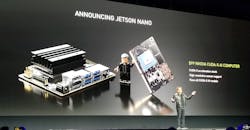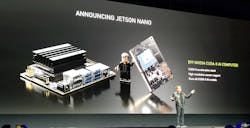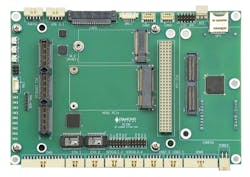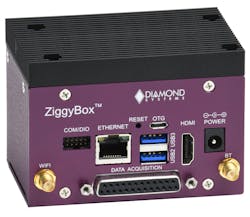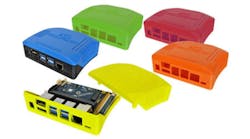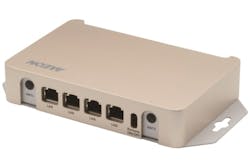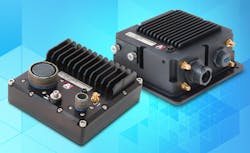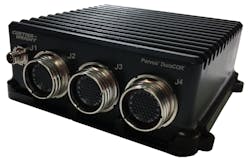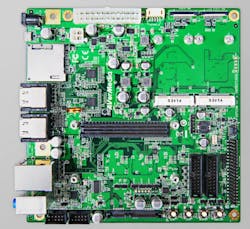This article is part of TechXchange: AI on the Edge
Machine learning (ML) continues to garner lots of designers’ mind share, and lots of hardware and software has been delivered to make developers’ jobs easier. NVIDIA is one of the companies at the forefront of this wave, so it’s not surprising that CEO Jenson Huang spent the entire keynote for this year’s NVIDIA GTC 2019 talking about the company’s new ML hardware and software solutions.
The bulk of the keynote addressed high-end ML support like Amazon’s AWS using the latest T4 GPUs to partnerships with Toyota. Squeezed in at the end was the announcement of the Nano Developer Kit and Jetson Nano module (Fig. 1). To me, this announcement was the most significant because the Jetson family is how most NVIDIA ML applications will be deployed.
1. At GTC 2019, NVIDIA's Jenson Huang introduced the Jetson Nano Developer Kit (left) and Jetson Nano module (right), the smallest Jetson family module.
Yes, many cloud-based solutions will be used as well, and there’s lots of money involved. But putting artificial intelligence (AI) on the edge requires platforms like the Jetson family, which now includes the Jetson Nano, TX1, TX2, and AGX Xavier. These provide scalable performance, allowing developers to select modules based on size, power requirements, and performance.
The trick is that the modules can’t be used alone. NVIDIA doesn’t sell the chips alone, only in these modules, so a carrier board is needed to host the modules. As it turns out, quite a few vendors are delivering products that support the Jetson series. This was readily apparent at this year’s Embedded Tech Trends, the Embedded World conference in Germany, and the GTC 2019 in San Jose.
A good example of this support is Diamond Systems’ Ziggy (Fig. 2), which supports the Jetson TX1 and TX2 modules. The Jetson TX1 and TX2 have the same form factor with difference costs and performance characteristics. The Jetson Nano and Jetson AGX Xavier work with different connectors and have different form factors, requiring different carrier boards.
2. Ziggy, developed by Diamond Systems, can support a Jetson TX1 or TX2.
Diamond Systems does have an adapter for the Jetson AGX Xavier called Stevie. This fits between the module and a carrier like the Ziggy that supports the Jetson TX1/TX2 form factor. Developers starting from scratch with the Jetson AGX Xavier are more likely to prefer Diamond Systems’ Elton (Fig. 3). The Elton is a PCe/104 carrier board that allows developers to mate a range of PCIe/104 boards to the Elton.
3. Diamond Systems’ Elton hosts an NVIDIA Jetson AGX Xavier, allowing it to work with PCe/104 expansion boards.
Many embedded-systems designers will be placing their systems into custom cases. However, Diamond Systems has the ZiggyBox (Fig. 4) for those who require the typical collection of interfaces without the need for major expansion options.
4. The ZiggyBox hides a Ziggy carrier for the Jetson TX1 or TX2.
As noted, Diamond Systems isn’t the only vendor supporting the Jetson family. I don’t have enough space here to present an exhaustive list of modules, although I suspect a list might be hidden on NVIDIA’s website.
Other carrier boards I’ve seen are Gumstix's AeroCore 2 for NVIDIA Jetson and Connect Tech’s Sprocket for the Jetson TX1/TX2. Connect Tech has multiple carrier boards and cases providing different interfaces and form factors for the entire Jetson family, including the Jetson Nano. Their Jetson Nano-Pac (Fig. 5) provides free 3D-printing files to match the carrier boards they have available.
5. Connect Tech’s Nano-Pac helps developers with free 3D-printing files for custom Jetson cases in order to match their carrier boards.
Aaeon’s Boxer-8120AI hosts a Jetson TX2 and a four-port switch (Fig. 6). It also exposes a pair of USB 3.0 ports and a USB OTG port plus wireless antenna sockets. It’s designed for rugged environments with an aluminum chassis with anti-dust protection. The system comes with the Jetson TX2 module.
6. Aaeon’s Boxer-8120AI hosts a Jetson TX2 and a four-port switch.
If you’re looking for really rugged designs, then check out Aitech’s industrial A176 and military A77 Twister (Fig. 7). It comes integrated with RedHawk Linux with hard real-time support. The conduction-cooled systems are sealed with rugged connectors.
7. The A176/A177 Twister from Aitech targets rugged industrial environments with its Jetson TX2 solution.
Aitech isn’t alone in the rugged industrial/military space with Jetson support. Curtiss-Wright’s Parvus DuraCOR 312 (Fig. 8) is also conduction-cooled and has space for a range of flash storage options. It can support eMMC, M.2, and removable 2.5-in. SATA SSD drives. It’s designed for 28-V dc MIL-1275/704/DO-160 power supplies found in aircraft and ground vehicles.
8. Curtiss-Wright’s Parvus DuraCOR 312 is available with a number of storage options.
The list could go on, but I’ll wrap up with AverMedia, which supplies a number of Jetson solutions including one for the Mini-ITX form factor (Fig. 9). The EX711-AA has a pair of full-height, Mini-PCIe slots, two HDMI-to-MIPI converters, a pair of USB 3.0 ports, SATA and SD card support, plus dual HDMI outputs. It’s designed to handle multiple video inputs as well.
9. Developed by AverMedia, the EX711-AA puts a Jetson TX1/TX2 module into a Mini-ITX motherboard.
Read more articles on this topic at the TechXchange: AI on the Edge
About the Author
William G. Wong
Senior Content Director - Electronic Design and Microwaves & RF
I am Editor of Electronic Design focusing on embedded, software, and systems. As Senior Content Director, I also manage Microwaves & RF and I work with a great team of editors to provide engineers, programmers, developers and technical managers with interesting and useful articles and videos on a regular basis. Check out our free newsletters to see the latest content.
You can send press releases for new products for possible coverage on the website. I am also interested in receiving contributed articles for publishing on our website. Use our template and send to me along with a signed release form.
Check out my blog, AltEmbedded on Electronic Design, as well as his latest articles on this site that are listed below.
You can visit my social media via these links:
- AltEmbedded on Electronic Design
- Bill Wong on Facebook
- @AltEmbedded on Twitter
- Bill Wong on LinkedIn
I earned a Bachelor of Electrical Engineering at the Georgia Institute of Technology and a Masters in Computer Science from Rutgers University. I still do a bit of programming using everything from C and C++ to Rust and Ada/SPARK. I do a bit of PHP programming for Drupal websites. I have posted a few Drupal modules.
I still get a hand on software and electronic hardware. Some of this can be found on our Kit Close-Up video series. You can also see me on many of our TechXchange Talk videos. I am interested in a range of projects from robotics to artificial intelligence.
